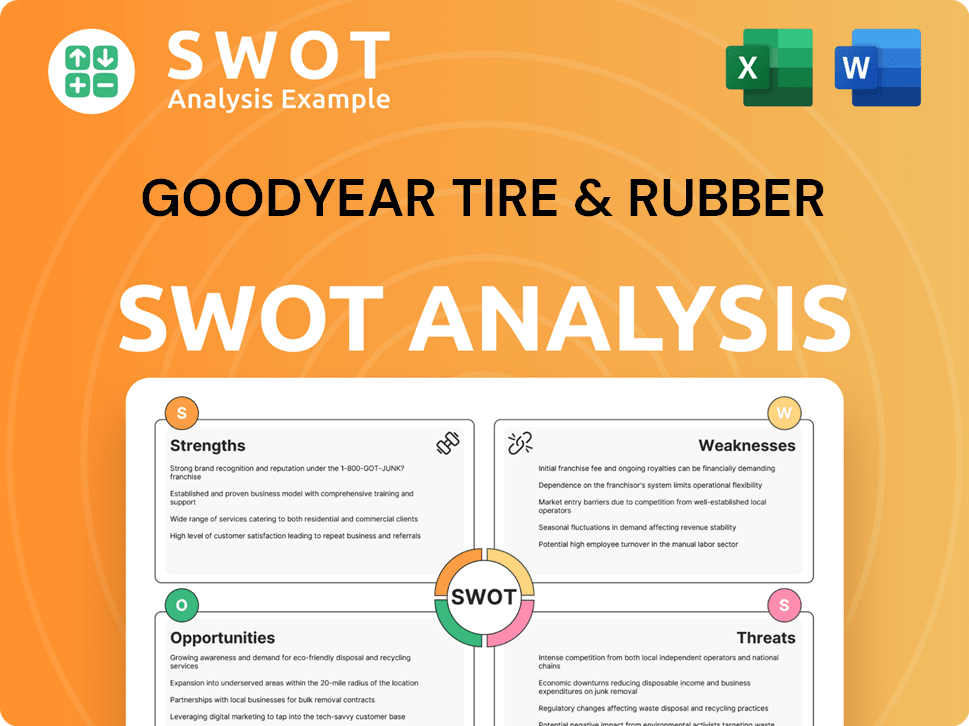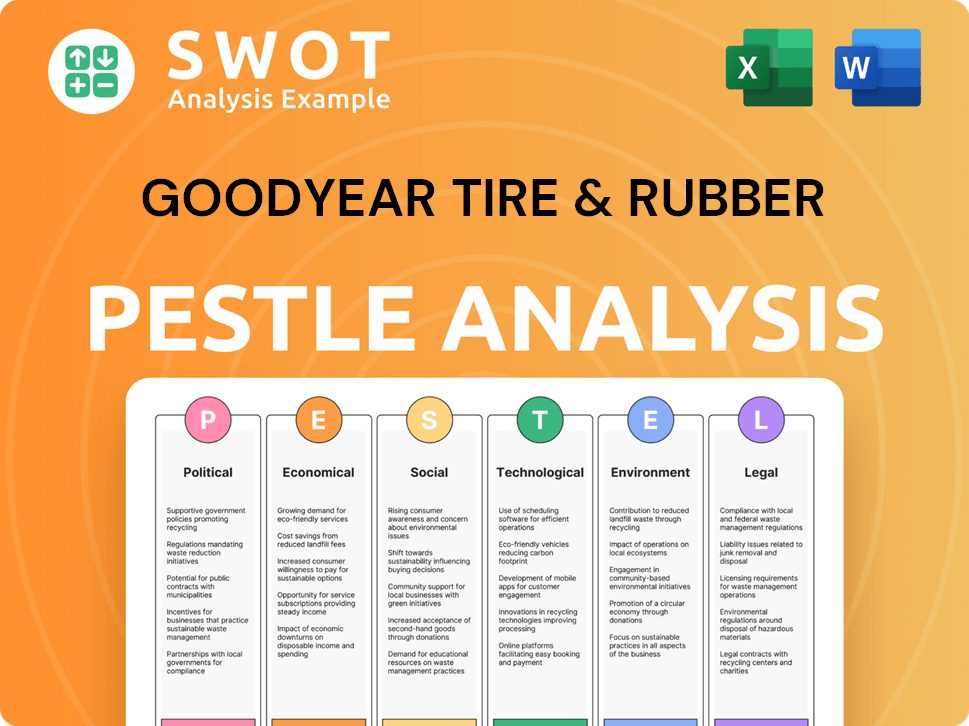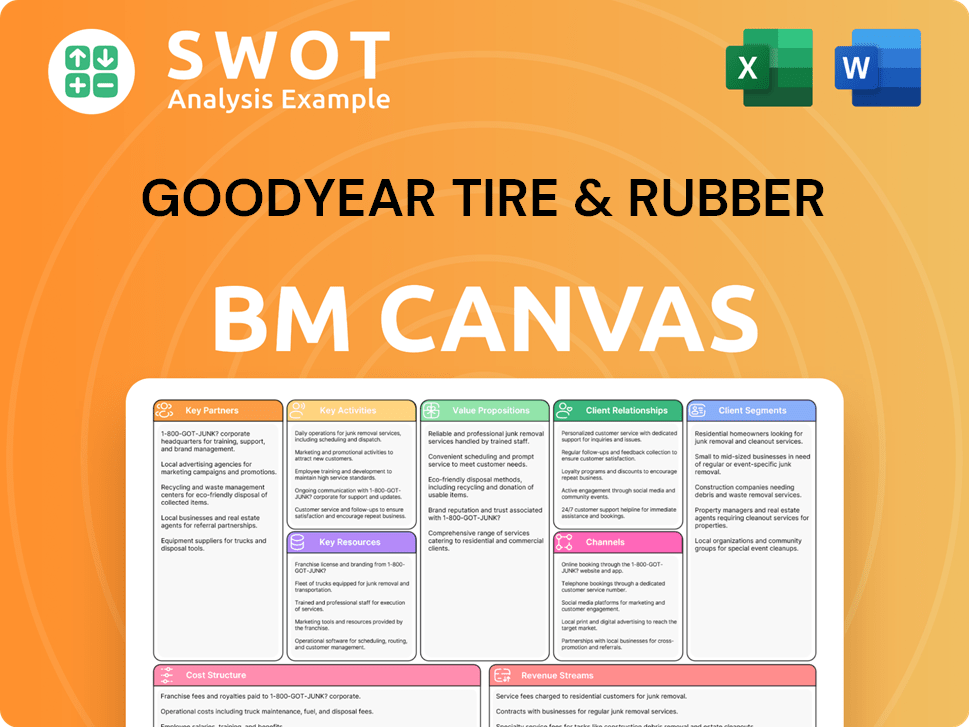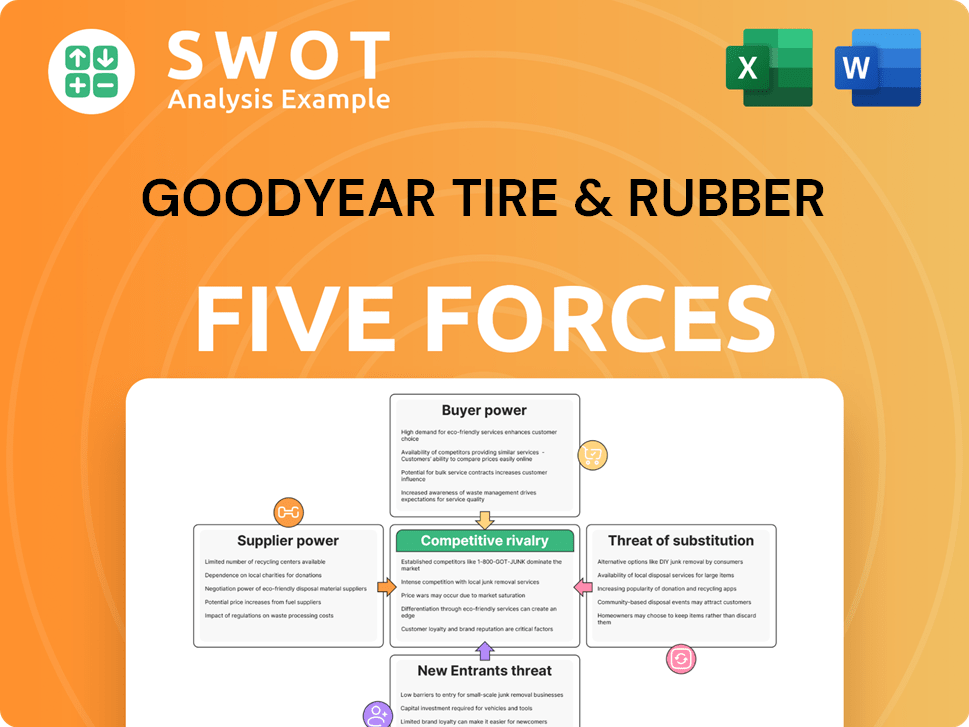Goodyear Tire & Rubber Bundle
How is Goodyear Navigating the Future of Tires?
Goodyear Tire & Rubber Company is undergoing a significant transformation, moving towards sustainable tire technology and smart mobility solutions. Founded in 1898, Goodyear has a rich history, evolving from bicycle tires to a global leader in the automotive industry. This article explores the company’s dynamic sales and marketing strategies in a rapidly changing market.

From its early days of direct sales to its current sophisticated approach, Goodyear's Goodyear Tire & Rubber SWOT Analysis demonstrates its adaptability. This piece will dissect Goodyear's sales strategy, examining its distribution channels and how it builds brand awareness. We'll also explore Goodyear's marketing strategy, including its digital marketing approach and advertising campaigns within the competitive tire industry marketing landscape, to understand its continued success.
How Does Goodyear Tire & Rubber Reach Its Customers?
The Goodyear sales strategy encompasses a diverse range of channels, blending traditional retail with modern digital approaches. This multifaceted strategy allows the company to reach a broad customer base, from individual consumers to large commercial clients. The evolution of these channels reflects the company's commitment to adapting to changing consumer behaviors and market dynamics, with a continuous focus on optimizing performance across all sales avenues.
Historically, physical retail locations and a vast network of independent dealers have been central to the Goodyear tire company's sales efforts. These channels provide direct consumer access to tire sales, installation, and maintenance services, emphasizing in-person service and expert advice. In recent years, the company has significantly expanded its digital footprint, recognizing the growing importance of e-commerce and the need to enhance its reach and provide consumers with convenient purchasing options.
The Goodyear marketing strategy also includes direct sales teams for its commercial and original equipment (OE) segments, fostering strong relationships with automotive manufacturers and trucking fleets. Wholesale distributors play a vital role in extending market penetration, especially in regions where direct retail presence may be limited. This strategic balance between various sales channels ensures a comprehensive market coverage and adaptability to different customer needs and preferences.
Goodyear operates a considerable number of retail locations and authorized dealer networks globally. These locations offer direct consumer access to tire sales, installation, and maintenance services, providing hands-on assistance and immediate product availability. This traditional channel remains crucial for customers seeking in-person service and expert advice, ensuring a strong physical presence in the market.
Goodyear has significantly expanded its digital footprint, with its official website serving as a primary online sales platform. The company has also partnered with major online retailers and e-commerce platforms. This strategic shift to omnichannel integration ensures a seamless customer experience across various touchpoints, adapting to the growing importance of online purchasing.
Goodyear utilizes direct sales teams for its commercial and original equipment (OE) segments. These teams foster strong relationships with automotive manufacturers, trucking fleets, and other industrial clients. This approach allows for tailored solutions and direct engagement with key partners, ensuring strong sales performance in these critical segments.
Wholesale distributors play a vital role in extending Goodyear's market penetration, particularly in regions where direct retail presence may be limited. This channel helps to broaden the company's reach and ensures product availability in diverse geographic locations. It supports the overall distribution strategy, complementing the direct sales and retail networks.
Goodyear's sales channels are designed to maximize market reach and adapt to evolving consumer behaviors. The company's approach combines traditional retail, e-commerce, direct sales, and wholesale distribution to create a robust and flexible sales strategy. This integrated approach allows Goodyear to cater to a wide range of customer needs and preferences, ensuring a strong market presence.
- Omnichannel Integration: Seamless customer experience across all channels.
- Digital Expansion: Focus on e-commerce and online partnerships.
- Strategic Partnerships: Collaborations with major retailers and platforms.
- Direct Sales: Strong relationships with commercial and OE clients.
Goodyear Tire & Rubber SWOT Analysis
- Complete SWOT Breakdown
- Fully Customizable
- Editable in Excel & Word
- Professional Formatting
- Investor-Ready Format

What Marketing Tactics Does Goodyear Tire & Rubber Use?
The Target Market of Goodyear Tire & Rubber Company employs a multifaceted marketing strategy, blending traditional and digital approaches to enhance brand awareness and drive sales. This strategy includes a strong emphasis on digital marketing, leveraging content, SEO, and paid advertising to reach a broad audience. The company also utilizes traditional advertising methods, such as TV and print, to maintain a robust brand presence.
Goodyear's approach focuses on data-driven insights to refine its customer segmentation and personalize marketing messages. This strategy allows for targeted promotions and efficient allocation of marketing resources. The integration of digital tools and analytics supports continuous improvement in campaign performance and customer engagement.
The company's marketing efforts are designed to cater to a diverse customer base, ensuring that the message resonates across various demographics and interests. By combining traditional advertising with digital strategies, Goodyear aims to maximize its reach and impact within the competitive tire industry.
Goodyear's digital marketing strategy includes content marketing, SEO, and paid advertising. This approach is crucial for driving traffic and engaging customers online. Email marketing and social media platforms are also key components of their digital presence.
Content marketing on the company's website and blog provides valuable information. This includes content on tire care, safety, and product innovations. This helps build trust and establish Goodyear as an industry leader.
SEO ensures high visibility in online searches, while SEM targets specific demographics. These strategies drive traffic to online platforms and dealer locations. This approach helps improve Goodyear's online presence.
Email marketing campaigns are used for customer retention and promotional offers. They are often segmented based on customer preferences and purchase history. This helps personalize customer experiences.
Social media platforms are actively used for brand engagement and customer service. This includes promoting new product launches and campaigns. This approach helps to build a strong online community.
Goodyear has historically engaged in collaborations that align with its brand image. This includes partnerships within automotive or lifestyle segments. This helps to expand brand reach.
Goodyear maintains a strong presence in traditional media, including TV, radio, and print. These channels reinforce brand image and reach a broad audience. The company also sponsors events to enhance brand visibility.
- TV, Radio, and Print Advertising: These are used, especially during major events.
- Event Sponsorships: Participation in motorsports and other events provides product demonstration opportunities.
- Data-Driven Marketing: Customer segmentation allows for personalized messaging.
- Analytics and Optimization: Tools are used to track campaign performance and optimize spending.
Goodyear Tire & Rubber PESTLE Analysis
- Covers All 6 PESTLE Categories
- No Research Needed – Save Hours of Work
- Built by Experts, Trusted by Consultants
- Instant Download, Ready to Use
- 100% Editable, Fully Customizable

How Is Goodyear Tire & Rubber Positioned in the Market?
The core of the brand positioning for the [Company Name] revolves around its heritage, emphasizing innovation, reliability, and performance. This positions the company as a premium tire manufacturer that prioritizes safety and quality. The brand often uses the message of 'driven to move' to highlight its commitment to progress and enabling mobility for consumers worldwide. The instantly recognizable winged foot logo further reinforces this sense of speed, freedom, and protection.
The company's marketing communications use an authoritative, trustworthy, and forward-looking tone, appealing to consumers who prioritize safety, durability, and technological advancement in their tire choices. The company differentiates itself from competitors through its long-standing reputation for pioneering tire technologies, such as run-flat tires and sustainable materials. The company's brand strategy focuses on maintaining a strong market presence by consistently delivering high-quality products and adapting to evolving consumer needs.
The company appeals to a broad target audience, from everyday commuters seeking reliable and safe tires to automotive enthusiasts and commercial fleet operators demanding high-performance and durable solutions. This is achieved by highlighting innovation in areas like fuel efficiency, wet grip, and extended tread life. The company's commitment to sustainability, through initiatives like developing tires from renewable materials and optimizing manufacturing processes, also resonates with environmentally conscious consumers. The company's Goodyear sales strategy and Goodyear marketing strategy are designed to maintain a strong brand image across all channels.
The company's brand identity is built on innovation, reliability, and performance. This heritage positions it as a premium tire manufacturer. The core message often revolves around 'driven to move', emphasizing progress and mobility.
The iconic winged foot logo is instantly recognizable, symbolizing speed, freedom, and protection. Marketing communications use an authoritative and trustworthy tone. This approach appeals to consumers who prioritize safety and technological advancements.
The company differentiates itself through pioneering tire technologies, such as run-flat tires and sustainable materials. This long-standing reputation sets it apart in the tire industry marketing landscape. Innovation is a key driver of its brand strategy.
The company appeals to a broad audience, from everyday commuters to automotive enthusiasts and commercial fleet operators. This broad appeal is achieved by highlighting innovation in fuel efficiency and extended tread life. This is a key element of its brand strategy Goodyear.
The company's brand positioning focuses on innovation, reliability, and performance, targeting a wide audience. The brand uses a clear visual identity and a trustworthy tone of voice. The company consistently ranks among leading tire brands in consumer satisfaction and brand recognition surveys.
- Prioritizes safety and quality, appealing to a broad audience.
- Emphasizes innovation and technological advancements.
- Maintains a strong brand presence across all channels.
- Focuses on sustainability through renewable materials and optimized processes.
Goodyear Tire & Rubber Business Model Canvas
- Complete 9-Block Business Model Canvas
- Effortlessly Communicate Your Business Strategy
- Investor-Ready BMC Format
- 100% Editable and Customizable
- Clear and Structured Layout

What Are Goodyear Tire & Rubber’s Most Notable Campaigns?
The sales and marketing strategies of the tire industry, particularly those employed by the tire company, are crucial for maintaining a strong market presence. The company has a history of impactful campaigns designed to enhance brand visibility and connect with its target audience. These initiatives are carefully crafted to drive sales performance and reinforce the company's position in a competitive landscape.
A key component of the company's marketing strategy involves leveraging its brand through various channels. This includes traditional advertising, digital marketing, and strategic partnerships. These efforts aim to showcase the quality and innovation of its products. Understanding the company's approach provides insight into the broader automotive sales and marketing strategies.
One of the most recognizable campaigns has been the 'Blimpworthy' initiative. This campaign highlights the company's association with major sporting events. It utilizes the iconic blimp to create memorable moments and strengthen brand recognition. The success of this campaign is measured by high brand recall and positive associations with quality and prestige.
The company maintains a strong presence in motorsports, particularly NASCAR. This long-standing partnership serves as a powerful marketing platform. It demonstrates the performance and durability of the tires under extreme conditions, building brand credibility and appealing to a performance-oriented audience.
The company is focusing on campaigns highlighting sustainable tire technologies. These campaigns aim to position the company as an environmentally responsible innovator. This involves digital content, public relations, and partnerships with environmental organizations, emphasizing the reduction of petroleum-based materials and improved tire performance.
The company's digital marketing approach includes social media marketing and targeted online advertising. These initiatives aim to engage with consumers directly. The company's social media marketing efforts often include interactive content, contests, and behind-the-scenes looks at product development and testing.
The company utilizes CRM systems to manage customer interactions and gather data. This helps in understanding customer preferences and tailoring marketing messages. CRM data also supports the company's sales performance analysis and future marketing budget allocation, ensuring resources are used effectively.
Advertising campaigns are a core element of the company's marketing strategy. These campaigns are designed to create brand awareness and drive sales. The company's advertising campaigns are often integrated across multiple channels, including television, print, and digital media, to maximize reach and impact.
- TV commercials during sporting events.
- Print ads in automotive publications.
- Digital ads on social media and websites.
- Partnerships with automotive influencers.
The company's brand strategy focuses on associating the brand with quality, performance, and innovation. This involves consistent messaging across all marketing channels. The company's brand strategy aims to build customer loyalty and differentiate its products from competitors. For additional insights, explore the Growth Strategy of Goodyear Tire & Rubber.
- Emphasis on tire technology and safety.
- Highlighting the company's history and heritage.
- Using endorsements from professional drivers.
- Sponsoring community events and initiatives.
Goodyear Tire & Rubber Porter's Five Forces Analysis
- Covers All 5 Competitive Forces in Detail
- Structured for Consultants, Students, and Founders
- 100% Editable in Microsoft Word & Excel
- Instant Digital Download – Use Immediately
- Compatible with Mac & PC – Fully Unlocked

Related Blogs
- What are Mission Vision & Core Values of Goodyear Tire & Rubber Company?
- What is Competitive Landscape of Goodyear Tire & Rubber Company?
- What is Growth Strategy and Future Prospects of Goodyear Tire & Rubber Company?
- How Does Goodyear Tire & Rubber Company Work?
- What is Brief History of Goodyear Tire & Rubber Company?
- Who Owns Goodyear Tire & Rubber Company?
- What is Customer Demographics and Target Market of Goodyear Tire & Rubber Company?
Disclaimer
All information, articles, and product details provided on this website are for general informational and educational purposes only. We do not claim any ownership over, nor do we intend to infringe upon, any trademarks, copyrights, logos, brand names, or other intellectual property mentioned or depicted on this site. Such intellectual property remains the property of its respective owners, and any references here are made solely for identification or informational purposes, without implying any affiliation, endorsement, or partnership.
We make no representations or warranties, express or implied, regarding the accuracy, completeness, or suitability of any content or products presented. Nothing on this website should be construed as legal, tax, investment, financial, medical, or other professional advice. In addition, no part of this site—including articles or product references—constitutes a solicitation, recommendation, endorsement, advertisement, or offer to buy or sell any securities, franchises, or other financial instruments, particularly in jurisdictions where such activity would be unlawful.
All content is of a general nature and may not address the specific circumstances of any individual or entity. It is not a substitute for professional advice or services. Any actions you take based on the information provided here are strictly at your own risk. You accept full responsibility for any decisions or outcomes arising from your use of this website and agree to release us from any liability in connection with your use of, or reliance upon, the content or products found herein.